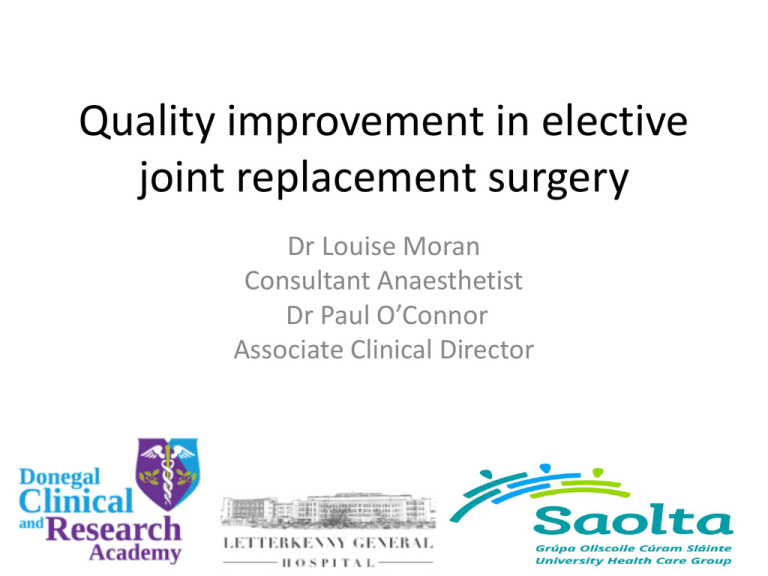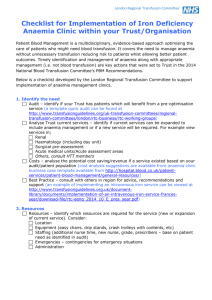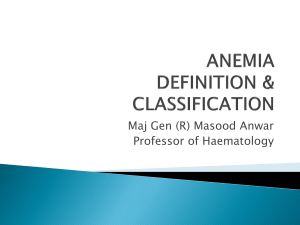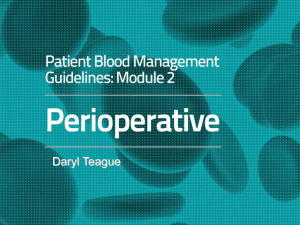
Quality improvement in elective
joint replacement surgery
Dr Louise Moran
Consultant Anaesthetist
Dr Paul O’Connor
Associate Clinical Director
• Letterkenny General Hospital (LGH) is an acute
general and maternity Hospital
• Serves 147,000 inhabitants of County Donegal
• 320 beds
• Saolta group
Letterkenny General Hospital
LGH - July 2013
• Redesigning Peri-operative Care for Patients
Undergoing Joint Replacement Surgery
– Dr Paul O’Connor
• Reducing Peri-Operative Blood Transfusions In
Patients Undergoing Elective Hip And Knee
Arthroplasty
– Dr Louise Moran, Mr Sean Murphy, Dr Anne Flood
Prospective randomised controlled trial
BMJ 2011;343:d7506
Blood Transfusions
• 10-90% of Total hip replacements
• 0-39% of Total Knee replacements
• 10% of all blood transfusion in the UK are
used for these two procedures
Boralessa H, Goldhill DR, Tucker K, Mortimer AJ, Grant-Casey J (2009).
National comparative audit of blood use in elective primary unilateral total hip replacement surgery in the UK. Ann Roy Coll
Surg; 91: 599–605.
Kotze, A., Carter, L.A. and Scally, A.J. (2012). Effect of a patient management programme on preoperative anaemia, transfusion
rate, and outcome after primary hip and knee arthroplasty: a quality improvement cycle. Br J Anaesth. 108, (6), 943-952.
Taylor C, Blest A, Lumley M, Hartley J, Baker C, Pailing M.West Midlands Regional Transfusion Committee Audit of Blood Use in
Orthopaedic Surgery Comparative Report 2005.
Blood transfusions can be bad...
• Preoperative anaemia / Autologous Blood
Transfusions (ABT)
• Increased risk of peri-operative adverse
outcomes
• Increased post-operative infections
• Increased hospital length of stay (LOS)
• Increased mortality.
Boralessa H, Goldhill DR, Tucker K, Mortimer AJ, Grant-Casey J (2009).
National comparative audit of blood use in elective primary unilateral total hip replacement surgery in the UK.
Ann Roy Coll Surg; 91: 599–605.
Blood management
programmes are good...
Goodnough LT, Maniatis A, Earnshaw P et al. Detection, evaluation, and management of preoperative anaemia in the elective
orthopaedic surgical patient: NATA guidelines. British Journal of Anaesthesia 2011; 106(1): 13-22.
How good was Letterkenny?
• Elective hip or knee replacement at
Letterkenny General Hospital
between 2010 and 2012 were
assessed retrospectively
• age and sex of the patients
• pre-operative haemoglobin (Hb)
• transfusion trigger Hb / reason for
transfusion
• number of units transfused
2010-2012
– 636 patients
– 2010 18%
– 2011 19%
– 2012 12%
Driver Diagram
Identify anaemia in pre-operative
patients (WHO guidelines)
Decrease the % of patients presenting to
surgery with anaemia
Treat anaemic patients to reduce preoperative anaemia
Design a treatment protocol for treating
anaemia within a limited time frame
To reduce the number of patients
receiving post-operative blood
transfusions in patients undergoing
elective knee and hip arthroplasty
from 12% to 6% by September 2013
in Letterkenny General Hospital.
Decrease intra-operative blood loss
Decrease inappropriate post-operative
blood transfusion
Implement protocol for administration
of tranexamic acid to pharmacologically
reduce blood loss
Agree transfusion triggers with a
multidisciplinary team approach
Implement regulation of blood products
by laboratory staff
Pre-surgery anaemic status of units received
140
120
130
Units
100
80
90
Number of Units received
60
40
59%
Percentage of units recieved
41%
20
0
Anaemic pre-surgery
Non-anaemic pre-surgery
Anaeimic status
Preoperative haemoglobin assessment and optimisation
This protocol is for patients undergoing major orthopaedic surgery in Letterkenny General Hospital. This work is based on/includes The National Blood Authority’s Patient Blood
Management Guideline: Module 2 – Perioperative which is licensed under the Creative Commons Attribution-NonCommercial-ShareAlike 3.0 Australia licence.
Preoperative tests
• Full blood count
• Iron studies2 including ferritin
• CRP and renal function
Is the patient anaemic?
Hb <130 g/L (male) or
Hb <120 g/L (female)
NO
YES
Ferritin <20 mcg/L2,3
Ferritin 20–100 mcg/L2,3
Ferritin >100 mcg/L
CRP4
Raised
No anaemia: ferritin
<100 mcg/L
•Consider iron therapy# if anticipated
postoperative Hb decrease is ≥30 g/L
•Determine cause and need for GI
investigations if ferritin is suggestive
of iron deficiency <30 mcg/L2,3
Iron deficiency anaemia
•Evaluate possible causes based on
clinical findings
•Discuss with gastroenterologist
regarding GI investigations and their
timing in relation to surgery3
•Commence iron therapy#
Normal
Possible iron deficiency
•Consider clinical context
•Consider haematology advice or, in
the presence of chronic kidney
disease, renal advice
•Discuss with gastroenterologist
regarding GI investigations and their
timing in relation to surgery3
•Commence iron therapy#
Possible anaemia of chronic disease
or inflammation, or other cause5
•Consider clinical context
•Review renal function, MCV/MCH
and blood film
•Check B12/folate levels and
reticulocyte count
•Check liver and thyroid function
•Seek haematology advice or, in the
presence of chronic kidney disease,
renal advice
Driver Diagram
Identify anaemia in pre-operative
patients (WHO guidelines)
Decrease the % of patients presenting to
surgery with anaemia
Treat anaemic patients to reduce preoperative anaemia
Design a treatment protocol for treating
anaemia within a limited time frame
To reduce the number of patients
receiving post-operative blood
transfusions in patients undergoing
elective knee and hip arthroplasty
from 12% to 6% by September 2013
in Letterkenny General Hospital.
Decrease intra-operative blood loss
Decrease inappropriate post-operative
blood transfusion
Implement protocol for administration
of tranexamic acid to pharmacologically
reduce blood loss
Agree transfusion triggers with a
multidisciplinary team approach
Implement regulation of blood products
by laboratory staff
Tranexamic Acid
• 2013 data
• 204 patients out of 231 received tranexamic
acid
• Hb drop decreased from 2.88g/dL to
2.24g/dL
• Transfusion rate
– 2.4% in tranexamic acid group
– 11.1% in non recipients of tranexamic acid
Driver Diagram
Identify anaemia in pre-operative
patients (WHO guidelines)
Decrease the % of patients presenting to
surgery with anaemia
Treat anaemic patients to reduce preoperative anaemia
Design a treatment protocol for treating
anaemia within a limited time frame
To reduce the number of patients
receiving post-operative blood
transfusions in patients undergoing
elective knee and hip arthroplasty
from 12% to 6% by September 2013
in Letterkenny General Hospital.
Decrease intra-operative blood loss
Decrease inappropriate post-operative
blood transfusion
Implement protocol for administration
of tranexamic acid to pharmacologically
reduce blood loss
Agree transfusion triggers with a
multidisciplinary team approach
Implement regulation of blood products
by laboratory staff
Inappropriate blood transfusions
• 48% of blood transfusions from 2010-2012
were potentially inappropriate
• Of those who required transfusion, 65% were
over transfused
• Introduction of governance of hospital blood
transfusion
How did we do?
Percentage of elective hip and knee
replacements requiring perioperative
blood transfusion
35
30
25
20
% transfused
% transfused nationally UK 2011
15
Project aim for % transfused
10
5
0
Q1
2010
Q2
2010
Q3
2010
Q4
2010
Q1
2011
Q2
2011
Q3
2011
Q4
2011
Q1
2012
Q2
2012
Q3
2012
Q4
2012
Q1
2013
Q2
2013
Q3
2013
Q4
2013
How did we do?
•
•
•
•
2010
2011
2012
2013
18%
19%
12%
3.5%
Potential health benefits
• Blood is an immunosuppressant
• Reduction in infections
– Pneumonia 2.6% vs 5%
– Periprosthetic joint infections 2% vs 4.3%
– Sepsis 6% vs 12%
– wound infections 4% vs 9%
Potential health benefits
• Length of stay (LOS)
– BMP reduced LOS from 6 to 5 days for THR
– BMP reduced LOS from 6 to 4 days for TKR
– In Letterkenny we reduced LOS from 8.8 days to
5.1
Potential health benefits
• Mortality
– 4.26% vs 6.44% all non cardiac surgery
– 2.43x mortality rate if have pre-operative anaemia
• Transfusion related immune modulation
– Association between ABT and cancer recurrence
• Incompatability / infection / coagulopathy
Musallam KM, Tamim HM, Richards T, et al. Pre-operative anaemia and post-operative outcomes in non-cardiac surgery:
a retrospective cohort study. Lancet 2011;378:1396–407.
Beattie WS, Karkouti K, Wijeysundera DN, Tait G: Risk associated with preoperative anemia in noncardiac surgery:
A single-center cohort study. Anesthesiology 2009; 110:574–81
Cost savings
• Unit of blood €250-€570
Year
2010
2011
2012
2013
No. of
units
transfused
80
76
64
8
Total cost
€20,000€45,600
€19,000€43,320
€16,000€36,000
€2000€4560
• Total saving €18,000 - €41,040
Potential national savings
• HSE in 2010 performed 4678 elective hip and
knee arthroplasties
• National average transfusion rate =25%
– €700,000
• Cost with a transfusion rate of 3.5%
– €100,000
• Potential savings of €600,000
• 1005 patients nationally could have avoided
ABT
Challenges
• Retrospective data collection
– Poor documentation
– Difficulty retrieving notes
• Pre-operative anaemia optimisation protocol
– Haematologist approval
– Pre-operative assessment nurse agreement
• Blood product regulation
– Blood bank regulation of transfusion triggers
– Single unit transfusion policy
• Maintenance of quality improvement project
Conclusion
• Small incremental changes are easier to make
than large ones
• Early stakeholder involvement and agreement
is necessary to evoke change
• We reduced blood transfusion in a specific
surgical population from 19% to 3.5%
• Reduction in morbidity and mortality
• Nationally 1005 patients could have avoided
transfusion
Conclusion
•
•
•
•
Cost savings locally €41,040
Potential cost saving nationally €600,000
LOS reduction of 1-2 days per patient
Expansion of the blood management
programme could be expanded across hospital
specialties
• Opportunity to develop a National Blood
Management Programme












